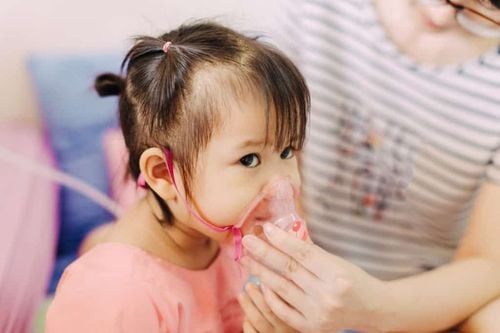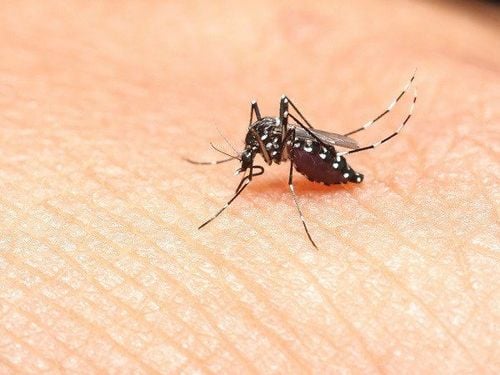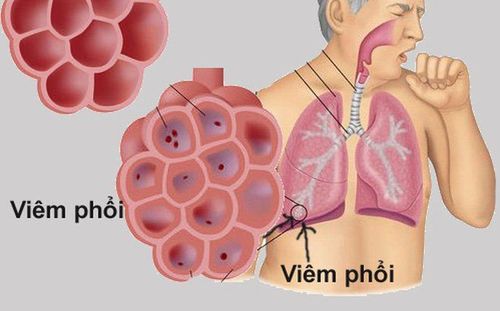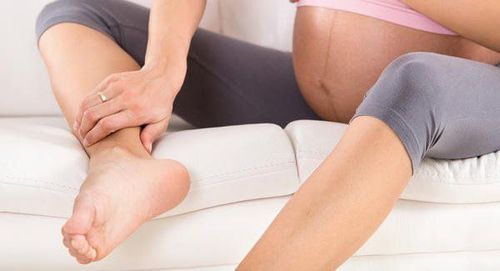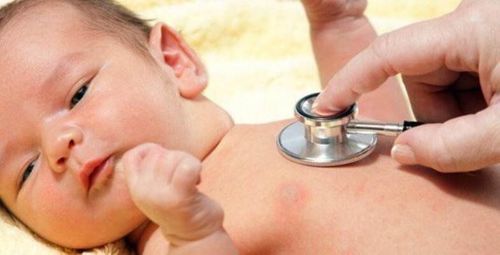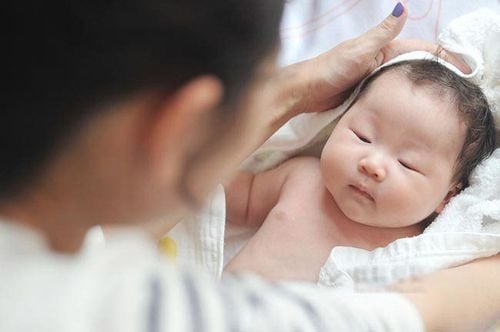This is an automatically translated article.
The article is expertly consulted by Assoc. Dr. Dr. Huynh Thoai Loan - Head of Pediatrics - Neonatology Department, Vinmec Central Park International General HospitalPneumonia is a common disease and one of the main causes of death in children if not detected early and treated promptly. Let's refer to the early recognition of pneumonia in children so that we can detect it in time and take proper care of the child.
1. What is pneumonia?
Pneumonia is an infection inside the lungs, which occurs when bacteria or viruses get stuck in this organ, they multiply and create infections. The most common bacteria is pneumococcal, and several other viruses also cause this disease.Illness can appear when the child is having a cough or flu. At this time, the mucus secreted in the lungs becomes a rich source of nutrients for bacteria. After a few days, bacteria and viruses can rapidly multiply, forming alveolar sacs filled with pus and infected mucus. Coughing is a very important self-defense reflex of the body, helping to push mucus out of the alveolar sacs before an infection gets in.
Pneumonia is a disease that, if not detected early and treated promptly, can be the leading cause of death in children under 5 years of age.
2. Causes and symptoms of pneumonia in children
There are many causes of pneumonia, in which the most common are: Pneumonia caused by bacteria, viruses, fungi, chemicals,...Children over 5 years old often have pneumonia caused by atypical bacteria. such as: Mycoplasma Pneumonia, Chlamydia Pneumoniae, pneumococcus, respiratory viruses.
Children under 5 years old often have bacterial pneumonia: Pneumococcal, Staphylococcus aureus, Streptococcus pyogenes, HiB. HiB was previously an important causative agent of pneumonia in children, but in the future, due to vaccination programs, this agent is now negligible.
Children under 2 months old, in addition to bacteria like those of children under 5 years old, can also encounter some intestinal bacteria such as: E.Coli, Proteus,... transmitted by their mothers.
Common in children under 1 year old, born prematurely, children with poor resistance, malnutrition, children in poor countries, poor economic conditions, sanitation, and medical care. Children often breathe in secondhand smoke from adults. The age of going to kindergarten or kindergarten, crowded places, ... are young subjects with a high rate of pneumonia.
Symptoms of pneumonia When seeing a child with the following pneumonia symptoms, parents should take their child to a medical facility for timely treatment.
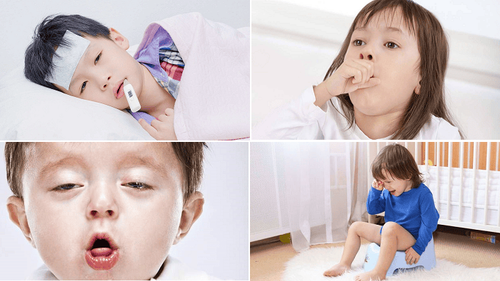
Moderate to severe cough, usually severe, but not necessarily. Continuous rapid breathing (different from temporary rapid breathing when the child has a high fever). Children are considered tachypnea if they breathe more than 60 times/minute (for children under 2 months of age), more than 50 times/minute (for children from 2 months to 1 year) or more than 40 times/minute (for children over 1 year old). year old). Count breaths while the child is lying still and inactive. Use a watch with a second hand to count to 1 minute. Exercising breathing: nasal flaps, moaning, intercostal muscle contraction (the soft position between the ribs is concave when the child breathes in), retraction of the sternum, chest indrawing. Rapid breathing and labored breathing are compensatory responses, but the child's body can't keep trying. If not treated promptly, the child may have respiratory failure, exhaustion, slow breathing and then stop breathing. Fever is moderate to high but sometimes absent in children with weakened immune systems Chest pain during and between coughs. Vomiting not only after strong coughs but also between coughs. Cyanosis around the lips and face due to lack of oxygen in the child. Stridor, although stridor is more often a sign of a viral infection, it can also sometimes be a sign of pneumonia. If your child has some of the above symptoms, it is likely that he or she has pneumonia. The most important are the three symptoms of cough, fever and rapid or labored breathing.
3. Treatment of pneumonia
When seeing a child with the above symptoms, parents should take their child to a medical facility, take X-rays, have blood tests and receive antibiotic treatment in a timely manner. Absolutely parents do not arbitrarily treat antibiotics at home. Cough is a good reflex to expel phlegm out of the airways, to clear the airways, so parents should not give children cough suppressants without a doctor's prescription.
Some ways to care for children with pneumonia parents can do to help children recover quickly are as follows:
Reduce fever for children: Actively apply warmth (the temperature of the water is determined by dipping the adult's elbow in it). basin of water, if the water is warm, it is okay). If the child has a fever over 38.5 degrees Celsius, they can take fever-reducing medicine as prescribed by the doctor. Drink more water to reduce fever and loosen phlegm.
Back patting and help children excrete sputum effectively: The method of patting a child on the back when a child has a cough with phlegm will help circulate the blood circulation of the lungs, help the phlegm in the bronchi loosen and be discharged easily. Parents do back patting, preferably before a meal or as early as 1 hour after eating to avoid causing vomiting, by flexing the hand at the wrist and then cupping it. Keep the thumb pressed against the index finger. Pat left then right, doing about 3-5 minutes in each area. Be careful not to hit the stomach, sternum or spine.
Instruct the child to cough: Coughing will open the airways, pushing secretions out of the lungs. For older children, ask them to cough after being patted in each area. When the child has not stopped coughing, do not continue patting.
Parents take the following steps:
Have the child sit up with his head tilted slightly forward. Breathe in. Open your mouth and contract your abdominal muscles to cough deeply, not in the throat. Inhale again. Continue coughing until the child is able to cough up sputum. For young children, nurses can use a vacuum cleaner to suck sputum out of the oropharynx when the child cannot cough up on its own. Hygiene and diet for children
Nose and mouth hygiene: If you use a soft tissue, wipe your nose and drool and discard the tissue immediately after use. If using a bucket towel, pay special attention to keeping the towel clean. The repeated use of contaminated and not washed bucket towels will create conditions for bacteria/viruses on the towels to return to the baby's body. Cleaning children's houses, toys and utensils. Caregivers need to wash their hands thoroughly when caring for and preparing food for children. Give your child nutritious, soft, easy-to-digest and easy-to-swallow foods. Feed children according to their needs, divide them into several meals a day and the amount of each meal is less than usual, do not force children to eat all the food that parents have prepared. You can use steamed kumquats with honey, steamed roses, ginger, and lemon for children to drink to relieve cough.
4. How to prevent pneumonia
The most common cause of pneumonia in young children is pneumococcal disease. Pneumococcal can also cause meningitis, sepsis, and ear infections, so the pneumococcal vaccine has been included in the routine immunization schedule of children. Take your children to be vaccinated fully and on time with vaccines such as: Diphtheria-pertussis-tetanus, Hib, influenza, pneumococcal...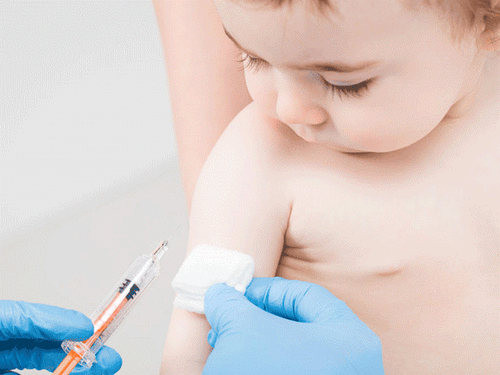
Early detection of respiratory infections such as: Cough, fever, runny nose, difficulty breathing, ... and other disorders such as diarrhea, poor appetite, slow weight gain to know how to take care and timely treatment.
Should breastfeed children from birth to 2 years old so that the child's body is fully developed and better able to resist diseases.
Parents should be equipped with enough knowledge on how to early recognize pneumonia in young children to have timely care and treatment to avoid unfortunate happenings. And when you see a child with the above symptoms, having difficulty breathing or fast breathing, it is necessary to immediately take the child to a reputable medical facility so that the doctor can promptly treat the child. Doctors at Vinmec International General Hospital always advise mothers after giving birth to give their babies vaccines to prevent diseases, especially for infectious diseases that children are susceptible to such as pneumonia, measles, etc. flu, ... to protect the health and ensure the comprehensive development of children.
In addition, Pediatrics is also a key area of Vinmec Health system, always bringing satisfaction to customers and highly appreciated by industry experts with:
Gathering a team of top doctors and nurses Pediatrics: includes leading experts, with high professional qualifications (professor, associate professor, doctorate, master), rich experience, worked at major hospitals such as Bach Mai, 108 .. The doctors are well-trained, professional, have a mind - range, and are knowledgeable about young psychology. Besides domestic pediatricians, the Department of Pediatrics also has the participation of foreign experts (Japan, Singapore, Australia, USA) who are always pioneers in applying the latest and most effective treatment regimens. . Comprehensive services: In the field of Pediatrics, Vinmec provides a series of continuous medical examination and treatment services from Newborn to Pediatric and Vaccine, ... according to international standards to help parents take care of their baby's health from birth to children. from birth to adulthood Specialized techniques: Vinmec has successfully deployed many specialized techniques to make the treatment of difficult diseases in pediatrics more effective: neurosurgery - craniofacial surgery, stem cell transplantation. blood in cancer treatment. Professional care: In addition to understanding children's psychology, Vinmec also pays special attention to the children's play space, helping them to play comfortably and get used to the hospital environment, cooperate in treatment, improve the efficiency of medical treatment. For more information on how to register for an examination with leading pediatricians Vinmec, please contact Vinmec medical system nationwide.
Please dial HOTLINE for more information or register for an appointment HERE. Download MyVinmec app to make appointments faster and to manage your bookings easily.





